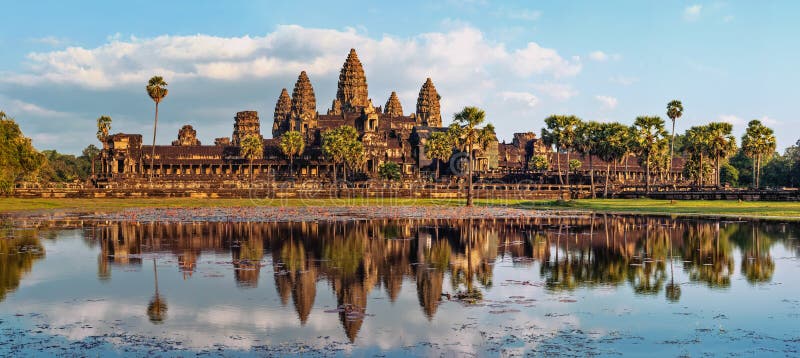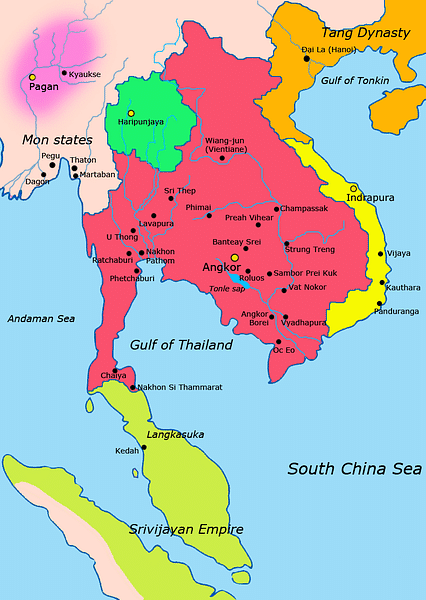When Henri Mouhot, a French naturalist and explorer, visited Angkor Wat in 1860, he described it as a monument built by “patience, strength, and genius.” These three words, I believe, are appropriate and relevant in describing the entire Classic Angkor civilization that flourished in Southeast Asia from 802 to 1327 CE. And yet, aside from some admiration for the architectural and sculptural creations of the Khmer, the world has not yet fully recognized the extent or significance of this great empire that existed for over 500 years. My preparation for teaching at the Cambodian Children’s Fund in Phnom Penh this year provided me with an opportunity to learn more about this missing link in world history. I am especially indebted to Michael D. Coe and Damian Evans for their excellent book entitled Angkor and the Khmer Civilization, which provided many of the insights that I discuss in this blog. I have also learned much about Classic Angkor civilization from my present-day Khmer friends. Although my knowledge is quite limited, I am going to risk exposing my ignorance by writing this blog about some aspects of the classic period and by drawing some conclusions about the future of Cambodia.

Daniel Boorstin coined the phrase “the latitudes of time” in his book The Discoverers to describe the chronologically parallel paths that geographically separated humans with common ancestry have taken on their historical journeys. “Broad and reasonably consistent patterns in human behavior and material culture across time and space,” are the words used by Coe and Evans to describe the same phenomenon. This concept requires us to recognize that others have been doing identical (or at least similar) things at the same time we have been doing things. For example, writing, which was created (not copied) in at least four (and probably more) separate world regions. The logical conclusion of accepting the latitudes of time hypothesis is that all groups of humans are “civilized.” There are no “barbarians” or “savages.” Nobody has a claim to being the originally and exclusively “civilized” part of the world. We have been lurching forward as (until recently) isolated groups of humans with roughly the same cognitive trajectory.
The Classic Angkor civilization is a good example of the latitudes of time: an empire every bit as politically powerful, intellectually inspired, artistically expressed, and culturally significant as the Greek and Roman empires that form the basis for so much of Western culture. The French must assume a good part of the blame for the fact that the significance and contributions of the Classic Angkor civilization (not just the art and architecture) are so vastly undervalued. The French were convinced of their “mission civilatrice,” their “God-given” right to impose French culture on “uncivilized” countries. Even Henri Mouhot thought that Angkor Wat had been conceived and constructed by a superior race which had disappeared, since the current inhabitants of Angkor were in a “state of barbarism” and could not have built such a monumental structure. The consequence of this arrogance, accelerated in 1863 when Cambodia became a “protectorate” of France, has been the dismissing of the richness of Khmer society and an underestimation of Khmer agency in the creation and transformation of their own, rich civilization.
The origins of the Khmer civilization have their roots in a natural phenomenon, namely the climate change that took place in Southeast Asia from 500 BCE to 500 CE. This climate change resulted in greater seasonality with wet and dry seasons, which created challenges which in turn gave birth to technological solutions. The Khmer devised a great hydraulic system to contain the floods of the wet season, and to store the water for the dry season. This system allowed the population to grow and prosper, resulting in the creation of a large, sophisticated, and powerful political entity that was involved in long-distance trade networks. Not quite globalization as yet, but certainly regionalization.
Khmer civilization had its “lift-off” moment during the reign of Jayavarman II, who ascended to the throne in 802 CE (coinciding with the high point of the Tang Dynasty in China and just two years after Charlemagne was crowned the Emperor of the Carolingian Empire). This moment marked the start of a Khmer empire with a universal monarch, religious pluralism and tolerance (Hindu and Buddhist), densely populated urban centers (in the case of Angkor with a million or more inhabitants), broadly-based literacy, a legal system based on Brahmanic law, an economic system based largely on non-money transactions, and a flourishing of the arts that included music, dance, theater, sculpture, and architecture that glorified the gods and provided them (the gods) with suitable accommodations. A curiosity was the fact that the most enduring feature of Khmer arts, namely the stone sculpture, was entirely anonymous. There was no record of a Khmer Michelangelo, although there must have been one or even several. Jayavarman II himself remained in office for 36 years, there being no term limit for Khmer rulers. In addition, succession seldom followed the rules familiar to Westerners.
Fast-forwarding (and this does great injustice to the achievements of the Khmer during the intervening three centuries) to 1113 CE, Suryavarman II ascended to the throne and commanded the construction of Angkor Wat. As yet another example of the latitudes of time, it was only 50 years later that the construction of the Cathedral of Notre Dame de Paris was started. Angkor Wat was finished in 36 years, but the French needed 182 years to complete Notre Dame. Angkor Wat is today recognized as a masterpiece of monumental architecture and planning, comparable to Beijing’s Forbidden City and Bernini’s colonnade facing St. Peter’s in Rome.
Khmer civilization reached its apogee around 1200 CE under the benevolent and compassionate rule of Jayavarman VII. At this point, the Khmer empire covered most of Southeast Asia and much of the areas that would in the 21st century be divided into the sovereign states of Cambodia, Myanmar, Thailand, Laos, and Vietnam.

In 1327, five centuries after its founding by Jayavarman II, the Classic Angkor civilization came apart at the seams. Nobody knows exactly why, but speculation focusses on several important stressors. First, the extensive water systems had altered the natural environment (think the Colorado River system in 2023) and were unable to adapt to the cycles of inundating floods and megadroughts. Second, an unexplained wave of religious intolerance (think the United States in 2023) fractured the population, Third, Thai enemies had grown in strength and were threatening Khmer dominance (think Russia in 2023).
Today, Cambodians are the direct lineal descendants of the Khmer of the Classic Period. They speak the same language as Suryavarman II. While they have been abused horribly by outsiders from the Western world (the French were the first but the Americans are equally culpable), this is a nation of proud, independent, and high-achieving people who are working diligently to overcome the deleterious effects of foreign intervention for more than 200 years.
The Cambodian Children’s Fund, which has allowed me to interact first-hand in the classroom with Khmer children, is undertaking an important and high-value project to re-ignite the vision and potential of the Classic Angkor civilization through the education of young Cambodians. I saw enough patience, strength, and genius in the students and teachers in my time at CCF to be optimistic about the future of the Kingdom of Cambodia.



